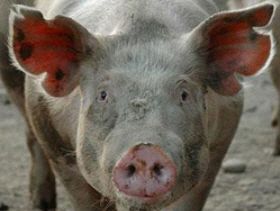 the past two months highlights the extra availability of pigs on the market, according to Iain Macdonald, Quality Meat Scotland’s Economics Analyst.
the past two months highlights the extra availability of pigs on the market, according to Iain Macdonald, Quality Meat Scotland’s Economics Analyst.Farmgate pig prices have fallen over 6p/kg from a seasonal peak of 164.5p/kg dwt at the beginning of June. The seasonal decline has come earlier this year and the increase through the spring and into summer was much less pronounced than in previous years. As a consequence, prices have fallen 9.5p/kg (5.5 per cent) behind last year’s levels.
"One likely contributor to the cooling of prices has been strong domestic production," said Mr Macdonald. "Defra slaughter data for UK abattoirs showed year-on-year increases in the prime pig kill of 2.5 per cent in May, 3.5 per cent in June and then 0.5 per cent in July, with the weekly average kill rising each month.
"In Scotland, slaughterings rose by 5 per cent in July. Furthermore, carcase weights have been heavier this year, averaging around 80kg at UK abattoirs between May and July 2014 compared with 78kg 12 months before."
According to Mr Macdonald, the combination of higher throughput and heavier weights pushed prime pig meat production up by 5 per cent year-on-year in May, 6 per cent in June and 2 per cent in July. Despite lower sow slaughterings, overall pig meat production was up by 3,400t (5.5 per cent) year-on-year at 64,500t in June, and then 2 per cent higher in July.
However, since the UK is around 60 per cent self-sufficient in pig meat, and around a quarter of domestic production is exported each year, external factors can have a significant influence on the UK market.
"The latest UK trade figures for June showed that pig meat imports increased by 1,000t (2 per cent) year-on-year to 50,400t while exports jumped by 2,400t (16.5 per cent) to 16,750t," said Mr Macdonald. "As a result, net imports were lower than in June 2013, though this was not sufficient to offset the increase in domestic production, leaving overall market supplies well above year earlier levels."
The external environment will also have had an impact through pricing channels. With the pound strengthening by around 6.5 per cent against the euro year-on-year this has forced exporters to lower sterling prices considerably to hold down euro prices and expand export volumes.
"In June, the average value per tonne of pork shipped to the EU was marginally higher in euro terms than 12 months before but returned 5 per cent less sterling, commented Mr Macdonald.
"At the same time, before even factoring in lower producer prices on the continent, a stronger pound has lowered the cost of importing pig meat from the continent, placing downward pressure on wholesale prices and hence the prices UK abattoirs are willing to pay for British pigs."
Highlighting the differential between current UK prices and those on the continent is EU Commission data for the week ending August 10. Whereas the EU average grade E pig price was 12 per cent lower year-on-year in euro terms, the UK price was up 2.5 per cent.
"In sterling, the EU average was 20 per cent lower," said Mr Macdonald. "Since the beginning of July, UK prices have drifted 2-3 per cent lower in both currencies while the EU average has fallen by 6-7 per cent."
The slide in European prices is more likely to reflect strong production and greater trade within the European market than the impact of the Russian ban on pig meat exports.
"Eurostat trade data shows that EU pork shipments to third countries grew 0.5 per cent year-on-year in May as the decline in sales to Russia was fully offset by an expansion into a wide range of markets including Korea, Japan, the Philippines, Australia, Serbia and the USA," commented Mr Macdonald.
"Meanwhile, pork trade between the 28 Member States of the EU was above 2013 levels throughout the first five months of this year, and ran 1.5 per cent higher in May."
Nevertheless, the recent decline in producer prices will have been manageable for most producers given the developments in feeding costs. Comparing feed costs now with those of late March 2013, the last time producer prices were at current levels, shows a 45 per cent decline for wheat and barley prices and a 12 per cent decline for soyameal.
Taking a longer-term view, UK sow slaughterings have been 3 per cent lower in the first seven months of 2014, compared with a marginal contraction of the UK sow herd reported in December.
"This suggests that producers are rebuilding herds to take advantage of the better margins achievable due to much lower feed costs," said Mr Macdonald. "Furthermore, considerable investment carried out in recent years has seen each sow producing more piglets, suggesting additional production growth is likely in 2015."





